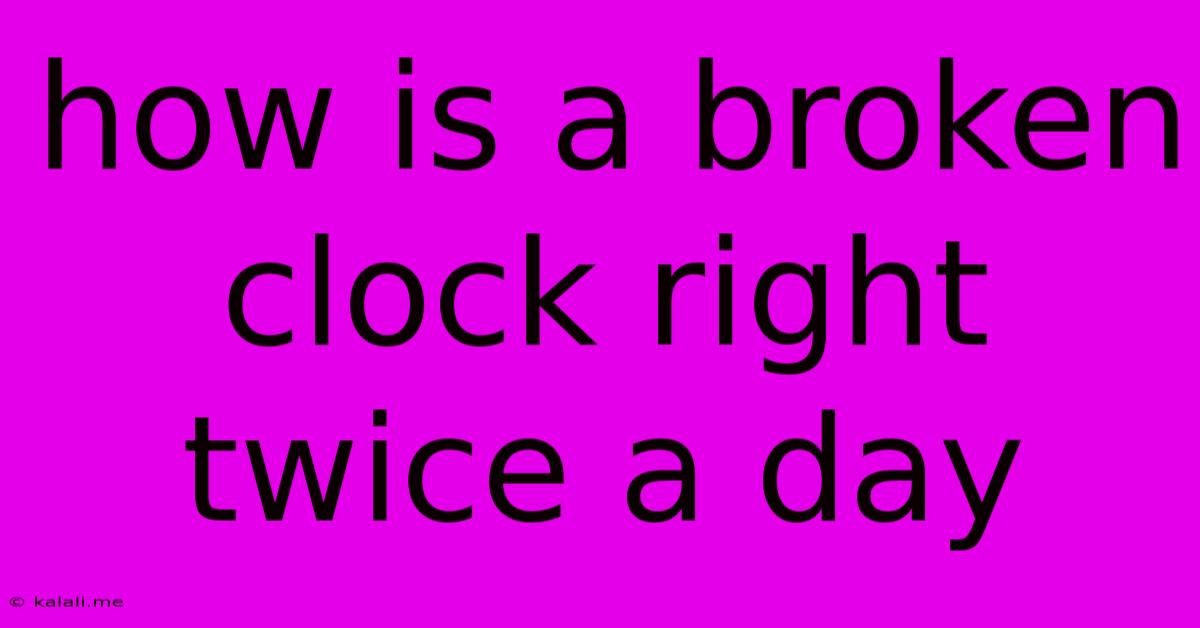How Is A Broken Clock Right Twice A Day
Kalali
May 19, 2025 · 3 min read

Table of Contents
How is a Broken Clock Right Twice a Day? A Deep Dive into a Familiar Riddle
This seemingly simple riddle, "How is a broken clock right twice a day?", hides a surprisingly insightful explanation about time, probability, and the nature of randomness. It's a great example of how something seemingly flawed can, by pure chance, align with reality. This article will explore the various interpretations of this riddle and delve into the underlying mathematics.
The Simple Explanation: The 12-Hour Cycle
The most straightforward answer lies in the 12-hour cycle of an analog clock. A broken clock, assuming its hands still move (even erratically), will, at some point during its 12-hour cycle, happen to show the correct time. Given that there are 24 hours in a day, this means it will be correct twice a day, once for each 12-hour period. This assumes the clock doesn't stop completely at some point.
Beyond the Simple Answer: Factors Affecting Accuracy
However, the reality is more nuanced. Several factors influence the accuracy of this "twice a day" assertion:
-
Type of Malfunction: The nature of the clock's breakage drastically alters the probability. A clock that's completely stopped will only be correct twice a day if it happens to stop at the exact correct time. A clock that runs slow or fast will still be correct twice a day, but the times it's correct will vary. A clock with a completely erratic movement pattern might be correct much less often.
-
Definition of "Correct": What constitutes "correct"? Are we talking about the exact second, minute, or just the hour? The stricter the definition, the lower the probability of the broken clock being accurate.
-
Randomness: The broken clock's behavior is, in essence, random. While we can predict a likely occurrence of accuracy twice a day, it's not a guarantee. If the clock's hands are completely immobile, except for being occasionally bumped into a correct position, the probability drastically changes.
The Mathematical Perspective: Probability and Statistics
We can apply basic probability and statistics to gain a clearer understanding. While calculating the exact probability of a broken clock being right twice a day requires making assumptions about the nature of its malfunction (is the movement random? Uniformly random?), the intuition behind the riddle remains. The 12-hour cycle provides two opportunities for accidental accuracy.
The Riddle's Deeper Meaning: Chance and Coincidence
Beyond the mathematics, the broken clock riddle speaks to the fascinating interplay of chance and coincidence. It highlights how even seemingly improbable events can occur, purely by chance, and this occurrence might be taken as proof of something more profound. We can consider this a parallel with many real-world situations where coincidences appear to hold more significance than they actually do.
Conclusion: A Simple Riddle, Complex Implications
The riddle "How is a broken clock right twice a day?" isn't just a playful puzzle; it's a miniature lesson in probability, statistics, and the unpredictable nature of randomness. While the simple answer satisfies the initial question, a deeper exploration reveals the nuances and complexities that make the riddle so enduringly intriguing. It invites us to contemplate the often-unpredictable nature of time and the surprising occurrences of coincidence.
Latest Posts
Latest Posts
-
Is Toothpaste A Liquid Or A Solid
May 20, 2025
-
A Form Of Leather That Was Popularised By Native Americans
May 20, 2025
-
How To Stop Pasta Sticking Together When Cold
May 20, 2025
-
How Do You Say Have A Good Day In Spanish
May 20, 2025
-
Can You Square Root A Negative Number
May 20, 2025
Related Post
Thank you for visiting our website which covers about How Is A Broken Clock Right Twice A Day . We hope the information provided has been useful to you. Feel free to contact us if you have any questions or need further assistance. See you next time and don't miss to bookmark.